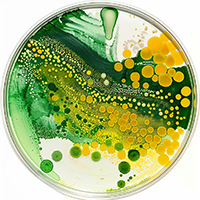Scientific Posters
Zymo Research's scientific posters highlight the latest breakthroughs in molecular biology, showcasing innovations spanning from epigenetics to microbiomics. We are proud to present insights from our collaborations with leading scientists and institutions worldwide, with more contributions to the field of life science on the horizon.
Featured Poster

An Integrated Approach for Pathogen Detection, AMR Monitoring, and Functional Analysis in Wastewater
X. Cheng , J. Wilkinson, K. Ngo , P. Baybayan, Y. Kim, P. Pham, E. Carrasco, S. Tang, J. Shen, and K. LockenWastewater surveillance has emerged as a pivotal tool in public health epidemiology. Particularly catalyzed by the Covid-19 pandemic, modern culture-independent sequencing methods have become indispensable due to their ability to offer a comprehensive perspective.
View PosterCorrelation Between Histone Modifications and 5-Hydroxymethylation in Human Brain
Yap Ching Chew, Adam Petterson, Tzu Hung Chung, Xueguang Sun, and Xi Yu JiaHistone tails that are exposed at the nucleosomal surface are targets for covalent modifications such as acetylation, methylation, and phosphorylation. These post-translational modifications play crucial roles in the regulation of chromatin structure and maintenance of genomic stability. DNA methylation of CpG dinucleotides is another epigenetic event involved in gene regulation. Recent studies demonstrated that 5- methylcytosine (5-mC) can be further modified to 5-hydroxymethylcytosine (5-hmC) by the ten-eleven translocation (Tet) family proteins. The balance between 5-mC and 5-hmC in the genome is a critical step for regulating gene expression to maintain cellular functions. 5-hmC is particularly enriched in the brain when compared to other tissues. However, the biological mechanisms linking histone modifications and 5-hmC in human brain and other tissues have not yet been established. Reduced Representation Hydroxymethylation Profiling (RRHP) is a method that combines whole-genome library preparation with selective adapterization and Next-Gen sequencing. Using RRHP, a new technique that map 5-hmC at single-nucleotide resolution in a strand-specific fashion, we analyzed the 5-hmC profiles of human male cerebellum. The correlations between 5-hmC and histone modifications are assessed using functional annotation analysis. We observed that 5-hmC enriched regions overlapped with H3K4me3 (a euchromatin mark)- associated regions, accounting for more than 50% of the overlap, whereas, only 25% of 5-hmC sites overlapped with H3K27me3 (a transcription repressive mark)-associated regions. Additionally, we also observed 12% of 5-hmC overlapped with bivalent domains which consisting both H3K4me3 and H3K27me3 marks. Taken together, our newly developed technique, RRHP provides new insight into the relationship between 5-hmC and histone modifications, and will be a powerful tool for future studies on the diverse regulatory roles associated with 5-hmC and histone modifications.
View PosterBisulfite Treatment of DNA: Perfecting the Deamination of Cytosine Into Uracil
Seth A. Ruga, Michael Karberg, Xi-Yu Jia, Marc E. Van EdenSodium bisulfite can deaminate “convert” cytosine in DNA into uracil, but does not affect 5-methylcytosine. Bisulfite treatment of DNA is a prerequisite for DNA methylation analysis for many epigenetics-based studies involving methylation profiling and the quantification of methylation status. However, analytical procedures involving bisulfite treated DNA are often subject to variability due to DNA degradation, incomplete conversion, and/or low yields of DNA. We have systematically investigated the procedure of bisulfite treatment of DNA paying particular attention to the chemistries involved in the process and to conversion rates in an effort to limit variability between samples and to improve upon conventional methods. We found conventional bisulfite DNA conversion chemistries could be improved such that increased C to U conversion efficiencies could be obtained without the levels of DNA degradation typically resulting from incubation of reaction mixtures at high temperature and nonphysiological pH. Essential to this process was prohibiting the occurrence of "over-conversion" of 5-methylcytosine into uracil that can occur in some situations and reaction conditions. We found the bisulfite conversion process could be simplified and the variability between treatments kept to a minimum by coupling heat denaturation with the bisulfite conversion process and by using in-column desulphonation to clean and purify the converted DNA. This new method was found to yield an average of > 80% recovery of input DNA with > 99% C to U conversion. The method has been specifically designed to accommodate (in addition to purified DNA) biological fluids, cells, or tissue directly as the input material. This makes its application for FFPE and LCM-derived samples particularly well suited.
View PosterDNA Methylation Biomarkers for Early Bladder Cancer Detection and Treatment Response Monitoring
Daneshmand S., Seyedian S.L., Ghodossipour S., Hamed A., Roberts S., Ghoreifi A., Basin M.F., Simin H., Piatti P., Bhasin J., Jara B., Sanossian L., Chew Y.C., Djaladat H., Schuckman A., Bhanvadia S., Liang G.Cystoscopy and urine cytology are routinely employed for the detection and monitoring of bladder cancer. Diagnostic accuracy of FDA approved urine-based tests is suboptimal and provide no, or limited, prognostic value. Herein, we evaluate the diagnostic values of the Bladder CARE Assay, a urine-based DNA methylation test recently granted with FDA Breakthrough Device Designation, in: 1) Detecting bladder cancer prior to current standard of care. 2) Identifying response to anticancer therapies. 3) Predicting tumor recurrence based on residual signal after TURBT
View PosterEpigenetic Biomarker Discovery and Validation for Diagnosis and Therapeutic Intervention for Hepatocellular Carcinoma
Xueguang Sun, Jill E. Petrisko, Lam K. Nguyen, Marc Van Eden & Xi-Yu JiaHepatocellular carcinoma (HCC) is one of the most common and lethal malignancies worldwide, accounting for approximately half a million annual deaths globally. HCC is completely asymptomatic in the early stages of the disease; therefore, early detection of HCC in afflicted patients is vital to receive therapeutic benefits from curative surgery. The standard diagnosis of HCC relies upon detection of the serum alpha-fetoprotein (AFP) level in at-risk subjects followed by hepatic ultrasonography to identify suspicious nodules. Accurate levels of AFP are often difficult to detect, and the imaging method to identify nodules is both operator-sensitive and subject to a high false-negative rate. While it is known that hepatocellular carcinoma is a multi-step process that requires altered expression of multiple genes, recent evidence has indicated that epigenetic abnormalities also play an important role in HCC. The discovery of reliable and accurate epigenetic biomarkers may open up new avenues for the development of novel diagnostic tools and provide a new target for therapeutic interventions.
View PosterEpiQuest- A Genomic Approach for DNA Methylation and Hydroxymethylation Analysis
Xueguang Sun, TzuHung Chung, Eliza Bacon, Ron Leavitt, Nikolas Isely, Marc Van Eden & Xi-Yu JiaDNA methylation and hydroxymethylation are some of the most important epigenetic modifications that can occur to the human genome. For instances, DNA methylation plays a vital role in the regulation of gene expression in normal cell development and aging, but also in the formation and progression of cancer and other diseases. Profiling DNA methylation and hydroxymethylation at the genome level promises large-scale identification of epigenetic biomarkers that could be applied to clinical and molecular diagnostic fields. Due to the availability of Next Gen sequencing technology, a number of new technologies have been developed for interrogating DNA methylation and hydroxymethylation at the genomic scale. Zymo Research has recently perfected sample prep and bioinformatic analysis as part of its new EpiQuest™ Methylation and Hydroxymethylation Profiling Services. These services combine next generation sequencing with Zymo's wellestablished epigenetic technologies and innovative bioinformatic algorithms for the most streamlined, comprehensive genome scale data generation to date. With EpiQuest… hundreds of epigenomic biomarker candidates can be discovered at once.
View Poster
